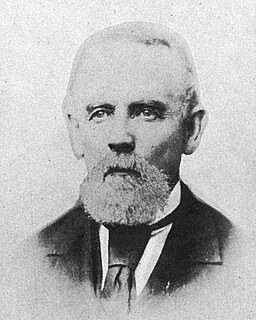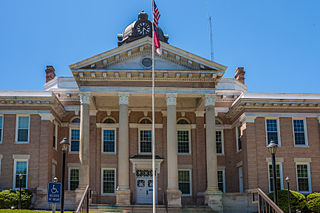
John Luke Porter, whose father was a shipwright at Portsmouth, Virginia, was born in 1813. He became a United States Navy civilian employee during the 1840s and a Naval Constructor in 1859. After resigning from the U.S. Navy in May 1861, he began working for the Confederate States Navy at the Gosport (Norfolk) Navy Yard, at Portsmouth. He played an important role in the conversion of the scuttled and burned steam frigate USS Merrimack to an ironclad, which became CSS Virginia when commissioned in February 1862.

CSSRichmond, an ironclad ram, was built for use in the American Civil War at Gosport (Norfolk) Navy Yard to the design of John L. Porter with money and scrap iron collected by the citizens of Virginia, whose imagination had been captured by the ironclad CSS Virginia. Consequently, she was sometimes referred to as Virginia II, Virginia No. 2 or Young Virginia in the South and as Merrimack No. 2, New Merrimack or Young Merrimack by Union writers, months before the actual CSS Virginia II was ever laid down.

James Wallace Cooke was an American naval officer, serving in the United States Navy and during the American Civil War serving in the Confederate Navy.

The first USS Miami was a side-wheel steamer, double-ender gunboat in the United States Navy during the American Civil War.

Charles Williamson Flusser was an officer in the United States Navy during the American Civil War.
CSSCotton Plant, sometimes referred to as Cotton Planter, was built at Philadelphia, Pennsylvania in 1860 and reportedly carried troops in the Pamlico River as early as September 1861. She sailed with CSS Albemarle when that ironclad ram attacked Union forces at Plymouth, North Carolina, sank USS Southfield and drove off USS Miami, USS Ceres and USS Whitehead on April 18–19, 1864. On May 5, 1864 she steamed as convoy to Albemarle from the Roanoke River en route to the Alligator River. The convoy was engaged by ships of the North Atlantic Blockading Squadron in the Battle of Albemarle Sound, but both the ram and Cotton Plant with several launches in tow escaped into the Roanoke River.

USS Southfield was a double-ended, sidewheel steam gunboat of the Union Navy during the American Civil War. She was sunk in action against the Confederate ironclad ram CSS Albemarle during the Battle of Plymouth (1864).

John Newland Maffitt was an officer in the Confederate States Navy who was nicknamed the "Prince of Privateers" due to his remarkable success as a blockade runner and commerce raider in the U.S. Civil War.

USS Ceres (1856) was a small 150 long tons (150 t) steamboat acquired by the Union Navy during the beginning of the American Civil War. She was outfitted as a gunboat and used in the Union blockade of the waterways of the Confederate States of America.
CSS Raleigh was originally a small, iron-hulled, propeller-driven towing steamer operating on the Albemarle and Chesapeake Canal. She was taken over by the State of North Carolina in May 1861, and transferred to the Confederate States the following July. Her commanding officer during 1861–1862 was Lieutenant Joseph W. Alexander. Her entire service was in coastal waters of North Carolina and Virginia and in the James River as part of the James River Squadron.
CSSRaleigh was a steam-powered Civil War casemate ironclad. She was fitted with a spar torpedo instead of an iron ram and was built in 1863-64 by the Confederate States Navy at Wilmington, North Carolina. While she was being built her commander was Lieutenant John Wilkinson (CSN). She was put into commission on April 30, 1864 under the command of Lieutenant J. Pembroke Jones, CSN.
The Battle of White Hall, also called the Battle of White Hall Ferry, took place on December 16, 1862, in Wayne County, North Carolina, as part of the Union expedition to Goldsboro, North Carolina, during the American Civil War.

USS Wyalusing was a double-ended, side-wheel gunboat that served in the United States Navy during the American Civil War. She was named for the borough of Wyalusing in Bradford County, Pennsylvania.

The Battle of Elizabeth City of the American Civil War was fought in the immediate aftermath of the Battle of Roanoke Island. It took place on 10 February 1862, on the Pasquotank River near Elizabeth City, North Carolina. The participants were vessels of the U.S. Navy's North Atlantic Blockading Squadron, opposed by vessels of the Confederate Navy's Mosquito Fleet; the latter were supported by a shore-based battery of four guns at Cobb's Point, near the southeastern border of the town. The battle was a part of the campaign in North Carolina that was led by Major General Ambrose E. Burnside and known as the Burnside Expedition. The result was a Union victory, with Elizabeth City and its nearby waters in their possession, and the Confederate fleet captured, sunk, or dispersed.

The Battle of Albemarle Sound was an inconclusive naval battle fought in May 1864 along the coast of North Carolina during the American Civil War. Three Confederate warships, including an ironclad, engaged eight Union gunboats. The action ended indecisively due to the sunset.

CSS Muscogee was an ironclad ram built for the Confederate States Navy during the American Civil War. She was known as Muscogee while being built and up until her launching; after that all surviving Confederate records refer to her as the "ironclad ram Jackson." No official explanation survives as to why her name was changed.
The Battle of Plymouth was an engagement during the American Civil War that was fought from April 17 through April 20, 1864, in Washington County, North Carolina.

CSS Neuse was a steam-powered ironclad ram of the Confederate States Navy that served in the latter part the American Civil War and was eventually scuttled to avoid capture by rapidly advancing Union Army forces. In the early 1960s, she produced approximately 15,000 artifacts from her raised lower hull, the largest number ever found on a recovered Confederate vessel. The remains of her lower hull and a selection of her artifacts are on exhibit in Kinston, North Carolina at the CSS Neuse Interpretive Center State Historic Site, which belongs to the North Carolina Department of Natural and Cultural Resources. The ironclad is listed on the National Register of Historic Places.




















